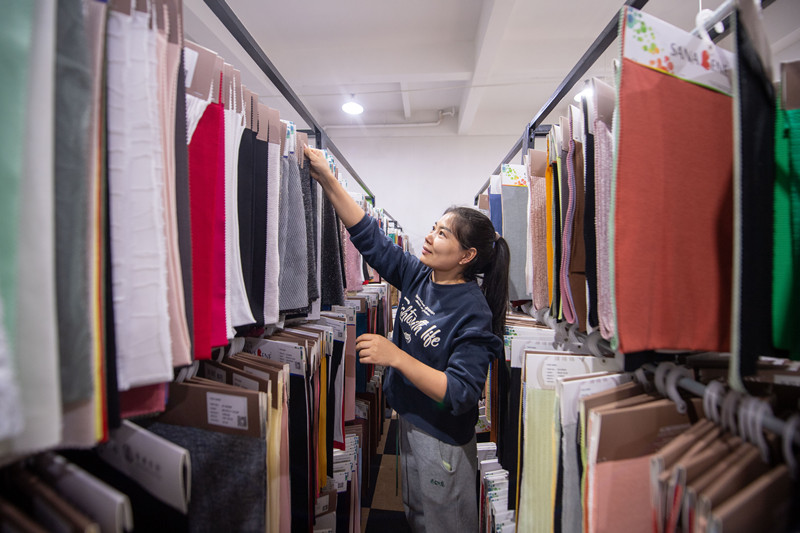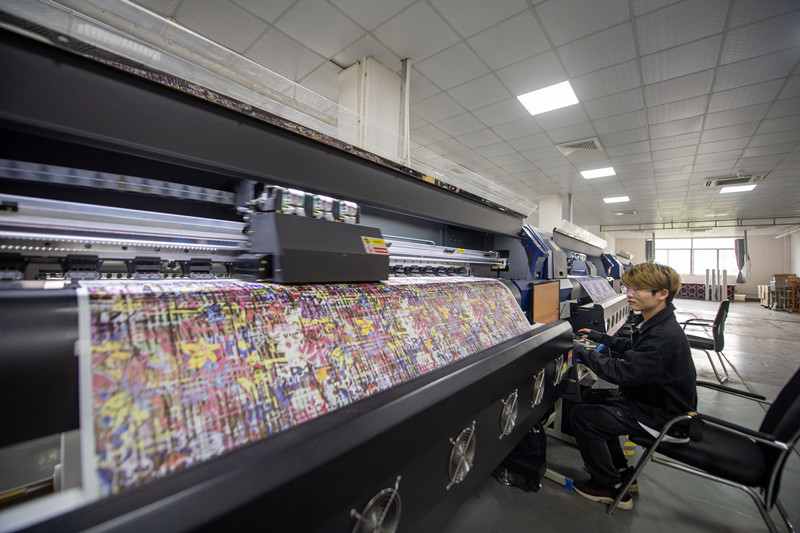
A fabric sample warehouse at a textile company in Keqiao District, Shaoxing, Zhejiang Province on November 2 (XINHUA)
Wide cotton fabric passes from a roller, through an open vat of dye and onto a printer at Baofang Printing and Dyeing Co. Ltd. in Keqiao District, Shaoxing, Zhejiang Province. The fabric is then dried, tagged, packaged and shipped off to a destination far away.
Fang Sheng, the company's deputy general manager, told Xinhua Daily Telegraph: "Our production volume is as high as 1.4 million meters every day, and our products, with their bright colors, are well-known overseas."
As one of the starting points of the ancient Maritime Silk Road, a conduit for trade and cultural exchange between China's southeastern coastal
areas and foreign countries, Zhejiang has long been a silk production and trading center. Under today's Belt and Road Initiative, a China-proposed initiative to enhance transcontinental connections, Keqiao has become an international textile hub with a complete industrial chain. Every year, a quarter of the world's textile products are traded here, selling to more than 190 countries and regions worldwide.
Top of the range
Mao Yuangen, Chairman of Heng Yuan Textile Co. Ltd. in Keqiao, recalled how he first arrived in the district in 1990 with 30,000 yuan ($4,200) borrowed from his relatives. Mao had his sights set on the local textile business. But 30 years ago, the place had no roads, and the cloth was transported from factories located across the river to the wholesale market by boat. "I sold polyester fabrics, which were very popular at that time, and was so busy I didn't even have time for lunch," Mao said.
In 1992, Keqiao's Shaoxing Textile Wholesale Market was renamed China Textile City.
Today, the district's annual textile product exports exceed 100 billion yuan ($14 billion). But entering the overseas market wasn't all smooth sailing for local businesses.
In 2002, one local company received an order from a Western country. However, as the business wasn't aware of the environmental standards of that particular country, it used the wrong dye and suffered huge losses as a result. The district's textile industry learned a valuable lesson: Its production standards had to be in line with international ones.
Printing and dyeing make up a large proportion of Keqiao's textile industry. Xu Hualiang, Chairman of a local printing and dyeing company, who has worked in the family business since he was 19, recalled that when he first visited his company's workshop more than 20 years ago, the sulfur dioxide fumes from the fabric dyes were overwhelming.
In 2010, facing the pressures of increased costs and improved environmental standards, the local government encouraged printing and dyeing companies to upgrade their equipment and products. "With advances in technology, management and design over the past few years, the district's textile industry has shed the stereotype of being a traditional, sunset industry and is becoming an advanced manufacturing and high value-added one."
Since taking over the company from his father in 2016, Shao Lingbin, General Manager of Big Tree Textile Science and Technology Co. Ltd., has dedicated himself to upgrading his products. He invited top designers from abroad to enhance the company's production lines and extended its product range from cloth to clothes.
"It was difficult in the first few years because developing high-end fabrics comes with soaring costs and we had to take many detours to reach our goal," he said.
Thanks to his persistence, his company eventually developed four superior fabrics, including acetate fabric which is created from wood pulp and is reminiscent of silk. The textiles are sold to overseas markets including the U.S., Southeast Asia and the Middle East.

The printing workshop of Big Tree Textile Science and Technology Co. Ltd. in Keqiao on November 2 (XINHUA)
Open and up
New technologies and materials have taken product quality to the next level. Jin Huangen, General Manager of Jinsheng Textile Co. Ltd. in Keqiao, said. "As people are more concerned about their health now, we have cooperated with research institutes to apply new technologies and new materials such as bamboo fiber, a sort of cellulose fiber extracted from naturally grown bamboo, to develop more products that benefit people's health." Being antimicrobial, bamboo fiber is said to be a very safe material for the body. Babies, people with allergies, and
others who are highly sensitive to infection have an additional layer of protection with bamboo fibers around them.
In July, Keqiao welcomed the establishment of the Zhejiang Modern Textile Technology Innovation Center. Over the next decade, the center aims to become an innovation platform for textile products used in medical care, transportation, national defense, military industry and marine engineering.
Qi Dongming, the center's deputy director, said ropes, lightweight auto parts and wind turbine blades made of various fibers have been applied in their respective industries.
For instance, a mooring cable developed using technologies from the center is used on the Shenhai-1 Drilling Platform, the world's first 100,000-ton deep-sea, semi-submersible oil production and storage platform. The cable is as strong as steel and more resilient, able to withstand storms and abrasion.
Keqiao has opened itself up, becoming a platform for international textile industry exchanges in recent years.
In 2018, it hosted the First World Textile Merchandizing Conference, with the intention of establishing a global cooperation system in the textile industrial chain and promoting innovation in the industry at large.
The district has also created a sound business environment to support local enterprises wanting to expand their business abroad.
For instance, in recent years, domestic textile enterprises were unable to participate in overseas exhibitions owing to the COVID-19 pandemic. Earlier this year, Keqiao's commerce bureau launched a program to entrust overseas branches of domestic institutions to partake in the exhibitions on behalf of Keqiao enterprises.
And so, in July, 30 local enterprises took part in the China Textile and Apparel Trade Show in New York, the U.S., presenting their latest products and exploring the American market.
In addition to going abroad, the district has welcomed a host of world-leading textile technologies. In 2020, the city of Milan, Italy, one of the world's fashion capitals, set up an exhibition and trading center in Keqiao to showcase high-end Italian fabrics.
Today, China Textile City has evolved into the world's largest textile hub. Last year, its transaction volume online and offline surpassed 300 billion yuan ($42.5 billion).
"We will continue to further open up and take part in global industrial cooperation to accelerate the building of an open city," Sheng Yuechun, Secretary of the Communist Party of China Shaoxing Committee, said.














